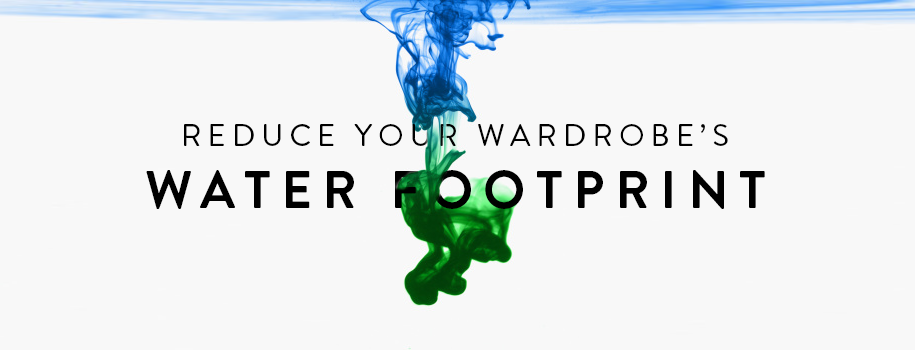
REDUCE YOUR WARDROBE’S WATER FOOTPRINT
“The process of transforming our industry into something more sustainable and more sensitive to our needs…takes time. It is a long term commitment to a new way of producing and consuming that requires widespread personal and institutional change” –Kate Fletcher
Today, we in the global apparel industry must confront a fashion paradox. In 1999 The Independent, a UK newspaper, ran an article on young eco-fashion designers and asked the question: “Is it possible to be fashionable and environmentally friendly?” At the time, pioneering eco-designers pressured manufacturers and retailers to become more environmentally conscious.
Meanwhile, another trend emerged called fast fashion. During the last two decades, fashion has become cheaper and faster. Globalized economies and markets, together with increased competition and the growth of offshore manufacturing, intensified demand and consumers’ desires. This has resulted in faster and faster fashion cycles that are unsustainable. The production and consumption of clothing represents the confluence of designers, manufacturers, retailers, and media handlers who create objects of desire called fashion.
Ironically, rather than becoming more environmentally friendly, current fashion industry practices are creating an even greater environmental crisis. Fast fashion threatens the world’s water resources in ways never seen before. Production of textiles consumes massive amounts of water, from growing crops to manufacturing practices and consumer usage practices. This includes the use of toxic chemicals creating pollution of water, which affects the health of plants, animals, and people.
We need new ways to innovate design thinking, the production of clothes, business models, and consumer behavior. We must learn to live with less. This means developing a new definition of fashion and a new set of values. Furthermore, design solutions must add “emotional meaning” in order to not be considered disposable items. Fast fashion is disposable fashion; good design gives back. Buy long lasting, crafted, high quality items that will be treasured for a long time and contribute to a lower rate of consumption. In the end, you will buy less, use less natural resources, and waste less. The winners will be both your environment and your health.
The fashion industry creates many serious impacts on our environment that directly affect the world’s water resources. These include:
- pesticides used for growing crops
- chemicals used to bleach, dye and finish textiles
- over usage of natural resources like plants and water
- substandard working conditions in the textile and clothing industry
- throwaway clothing in landfills sites
- excessive amounts of non-degradable packaging
In my opinion, a major issue most fashion consumers generally do not think about is water usage. The textile industry is the third largest consumer and polluter of the world’s water. Did you know that cotton farming is the single largest consumer of water in the apparel supply chain? Water consumption is a huge problem for growing fibers such as cotton, with nearly 400 gallons of water required to produce one cotton or cotton blend T-shirt. The T-shirt is the one item that we are most likely to own, and it is the most water-consumptive. Areas where water is on the verge of being totally depleted include the Tarim Basin in China, the Murray-Darling Basin in Australia, and the Aral Sea region in Central Asia. The draining of the Aral Sea in Central Asia stands as one of the most damning examples of unsustainable production. In less than a generation, it shrank to 10 percent of its former volume. Wastewater is another major issue. Toxic chemicals from the dyeing of textiles, along with chemicals used to produce synthetics, are contributing to a major crisis in the pollution of fresh water that affects the health of animal species and humans.
As a consumer, you can reduce your wardrobe’s water footprint. Support manufacturers like Patagonia and Levis Strauss, who act on sustainability-focused innovations in a growing number of their fashion products. Recently, Levi Strauss announced it saved one billion liters of water through its Water<Less process, which reduces water used in the lifecycle of a pair of jeans by up to 96%. The latest study builds upon the 2007 study of a pair of Levi’s 501 jeans, which took 3800 liters of water (1003.85 gallons), cotton cultivation (68%) and consumer care (23%) continue to have the most significant impact on water consumption. Americans use more water and energy to wash and dry their jeans than consumers in other markets. Levi Straus states that by wearing your jeans ten times before washing, American consumers can reduce their water and climate change impact by 77%.
There is a lot of attention on the energy, chemicals, and water that go into making a garment.
Yet consumers do not know that the majority of the environmental damage done takes place after they purchase a garment. The energy and water required to wash a garment has far more devastating effects than the growing of the materials and the manufacturing of the textiles. The impact of people washing clothes at home is important: 40% of domestic water footprints stem from laundry, a significant proportion of which comes from washing clothes by hand in the developing world. When doing laundry, fill to full capacity rather than half full. Wash in cold water with phosphate-free detergents and wear clothes more than once, therefore washing with less frequency. Be on the lookout for advanced technologies and washing machines with a low water and detergent footprint entering the market.
